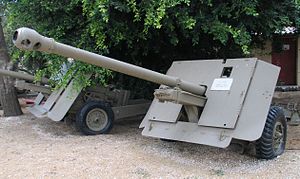Ordnance QF 17 pdr
| Ordnance QF 17-pounder | |
|---|---|

17-pounder in Batey ha-Osef museum, Israel
|
|
| Type |
Anti-tank gun Tank gun |
| Place of origin | United Kingdom |
| Service history | |
| In service | 1943– |
| Used by | British Commonwealth |
| Wars |
World War II, Korean War |
| Production history | |
| Designed | 1941–42 |
| Produced | 1942- |
| Specifications | |
| Weight | 3 long tons (3.05 t) |
| Barrel length | 13 ft 9 in (4.191 m) 55 calibres |
|
|
|
| Shell | 76.2×583mmR |
| Calibre | 3 inches (76.2 mm) |
| Carriage | Split trail carriage, with gunshield. |
| Elevation | -6° to +16.5° |
| Traverse | 60° |
| Muzzle velocity | 2,900 ft/s (880 m/s) HE, HEAT 3,950 ft/s (1,200 m/s) APDS |
| 77 mm HV | |
|---|---|

77 mm HV Mk2 on a prototype armoured car
|
|
| Type | Tank gun |
| Place of origin |
|
| Production history | |
| Designer | Vickers |
| Manufacturer | Vickers |
| Specifications | |
| Weight | 1,502 pounds (681 kg) |
| Length | 165.5 inches (420 cm) |
|
|
|
| Calibre | 76.2 millimetres (3.00 in) |
| Elevation | +20/-14 on Comet |
| Effective firing range | 2,000 yards (1,800 m) |
The Ordnance Quick-Firing 17-pounder (or just 17-pdr) was a 76.2 mm (3 inch) gun developed by the United Kingdom during World War II. It was used as an anti-tank gun on its own carriage, as well as equipping a number of British tanks. It was the most effective anti-tank gun of the war fielded by the Western Allies (that is, excluding the Soviet Union). Used with the APDS shot, it was capable of defeating all but the thickest armour on German tanks. It was used to 'up-gun' some foreign-built vehicles in British service, notably to produce the Sherman Firefly variant of the US M4 Sherman tank, giving British tank units the ability to hold their own against their German counterparts. In the anti-tank role, it was replaced after the war by the 120 mm BAT recoilless rifle. As a tank gun, it was succeeded by the 84 mm 20 pounder.
Before the QF 6-pounder had entered service, the British predicted that it would soon be inadequate given the increasing armour of German tanks. In late 1940, the design of a replacement began, and was largely completed by the end of 1941. A prototype production line was set up in spring 1942, and with the appearance of Tiger I tanks in early 1943 in the North African Campaign, the first 100 prototype 17-pounder anti-tank guns were quickly sent to help counter this new threat. So great was the rush that they were sent before proper carriages had been developed, and the guns had to be mounted in the carriages of 25-pounder gun-howitzers. These early weapons were known as 17/25-pounders and given the codename Pheasant. They first saw action in February 1943.
Fully developed 17-pounders started production in 1943 and were first used during the Italian Campaign. They became one of the most effective weapons on the battlefield, on both carriages and tanks.
...
Wikipedia
